AMD Phenom II X4 940 Black Edition Review
AMD Phenom II X4 940 Black Edition
AMD finally gets on the 45nm bandwagon but can its new quad core CPUs finally compete with Intel? Ed finds out.
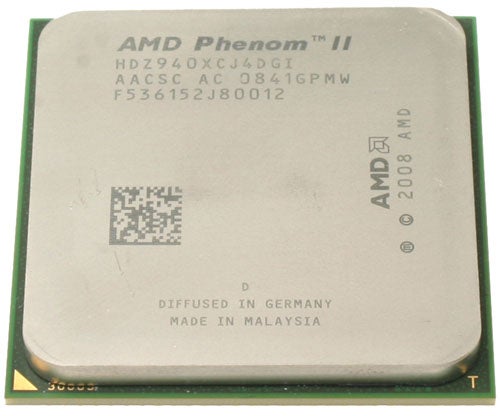
Verdict
Key Specifications
- Review Price: £229.99
Today AMD released the latest addition to its CPU line-up, the aptly named Phenom II range. These quad core processors will eventually completely replace the existing Phenom series and, for the foreseeable future, be AMD’s answer to Intel’s new Core i7 processors. 
For today’s launch there will be only two processors available, the Phenom II 940 Black Edition and Phenom II 920. The former will run at 3.0GHz (a marked increase from the previous Phenom’s best of 2.6GHz) and cost a relatively modest $275 while the latter runs at 2.8GHz and comes at an even more reasonable $235. Compare this to the prices of even the cheapest Core i7 and it doesn’t take a genius to work out that these Phenoms, despite their improvements, won’t be gunning for the top performance spot. Nonetheless, considering how little most of us utilise the power of even modest dual-core processors, there’s still plenty of reason to consider AMD’s latest. 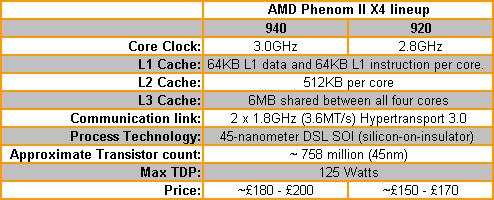
The key difference between the first generation Phenoms and the Phenom IIs is the move from manufacturing the chips on a 65nm process to a 45nm process. This yields chips that consume less power and produce less heat than the equivalent designs on the older process, which means CPUs can either run at the same speed as before but consume less power or run faster for the same power usage.
Another result of the shrink is either an increase in the number of chips that can be produced per wafer of silicon (making them cheaper) or that the same number of chips can be produced with more logic crammed into the same space.
It’s this latter route that AMD has taken with the Phenom II. The actual chip is almost identical in size to the existing Phenom but it incorporates around two thirds more transistors – up from ~450 million to ~758 million. 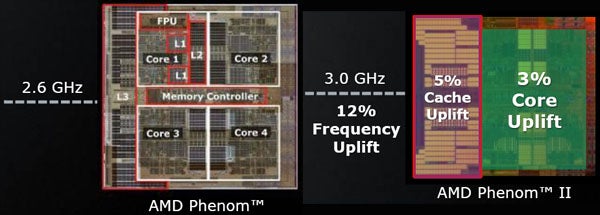
A large proportion of this extra silicon is taken up by an increased amount of on-die cache memory. Just like previous Phenoms, Phenom II uses three levels of cache with the first two levels remaining at 128KB (64KB for instructions, 64KB for data) and 512KB per core. However, the third L3 level has increased from 2MB all the way up to 6MB, which is shared by all four cores. AMD estimates this accounts for around a five per cent performance increase over previous Phenoms. Obviously this is something that’s impossible for us to test directly so we’ll have to take its word for it.
Besides the cache and clock frequency increases, there aren’t too many fundamental changes to the core CPU design. That said, a number of tweaks have been made to both increase performance and reduce power usage.
For a start, AMD has improved Cool and Quiet (CnQ) – the technology that reduces clock speeds when parts of the processor are idle. The previous incarnation would dynamically clock each core independently, which in theory sounds great but because of the way Windows Vista handles the distribution of tasks across multi-core processors, it could result in reduced performance. But by going backwards and simplifying the CnQ to dynamically clock all four cores at once, the new Phenoms don’t see a performance hit anymore. So it’s now safe to have CnQ on all the time.
Another power saving improvement comes from the new ability of idle cores to flush out the contents of its L1 and L2 caches (remember these are normally only readable by one core) to L3 cache (which the other cores can read). The processor can then halt clocks to the idle core and consequently save power. It’s not a complete shutdown of the core like Intel has managed with its Core i7 architecture but it’s better than what came previously.
As for those under the bonnet performance increases, AMD was actually relatively tight-lipped about most of them, simply claiming that when combined they added an extra three per cent to the overall performance improvement. In fairness, the technicalities of what’s going on with those improvements is probably beyond the scope of this article anyway. After all, you buy a CPU based on the end result, not how and why it got there. 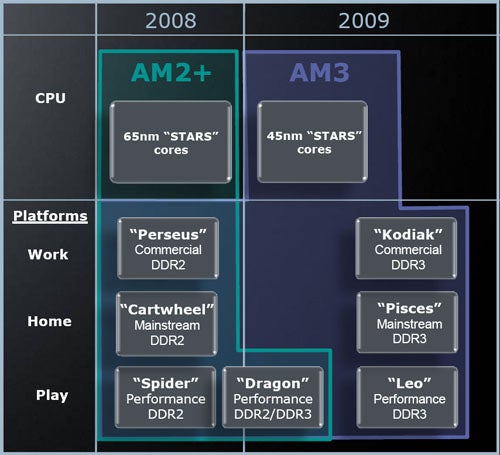
Two versions of Phenom II will eventually be available. The current versions use AMD’s current AM2+ packaging. This means owners of AMD motherboards bought within the last couple of years will be able to simply swap their old CPU for a new one (mileage may vary here so you should check your motherboard manufacturer’s website). You’ll just need to update the BIOS, which in this day and age is quite a simple process. Obviously this is a huge ‘cost of ownership’ advantage for AMD compared to Intel, even without comparing the actual prices of the CPUs.
The second version of Phenom II will be based on its new AM3 packaging, the principle advantage of which will be a move to DDR3 support. This will also be AMDs package of choice for its brand new CPU designs (remember Phenom II is essentially just a tweaked design) when they eventually arrive. 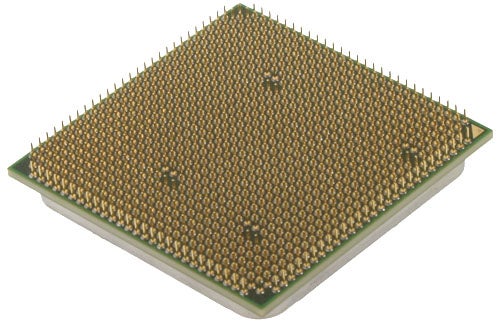
That’s pretty much the essence of Phenom II, so to see if all this theory holds up and whether Phenom II is actually worth laying down your hard earned cash for, it’s time to do a bit of testing.
As with our Core i7 performance analysis, we’ve taken a consumerist stance with our testing, eschewing theoretical memory bandwidth benchmarks and raw floating point calculation performance metrics for real world tasks. There are a couple of ‘canned’ benchmarks in the form of the 3D rendering tests, Cinebench and POV-Ray. However, these are industry standard benchmarks that we feel people value, as they can easily be downloaded and run by anyone.
”’Test Setup”’
”’Common System Components”’
AMD ATI Radeon 4870 X2 Graphics Card
Western Digital Raptor X 150GB Hard Drive
Pioneer BDC-S02BK Blu-ray Drive
”’Core i7 Test System”’
Intel DX58SO ”SmackOver” Motherboard
2 x 1GB Qimonda IMSH1GU03A1F1C-10F PC3-8500 DDR3 RAM
”’Core 2 test Sytem”’
Asus P5E3 Motherboard
2 x 1GB Qimonda IMSH1GU03A1F1C-10F PC3-8500 DDR3 RAM
”’AMD Phenom Test System”’
Gigabyte MA-790GP-DS4H Motherboard
2 x 1GB Corsair Dominator CM2X1024-8500C5D DDR2 RAM
It’s arguable that for many of you, gaming performance will be of paramount interest when it comes to buying new parts for your PC. However, the simple fact of the matter is, if you have a powerful gaming PC, CPU performance is not going to be your bottleneck. So as long as you have a reasonably nippy dual core or quad core CPU, you’ll be fine. It’s for this reason we didn’t go to town with our game testing and have looked at just two games, Crysis and Enemy Territory: Quake Wars.
Both games use scripting to run through a custom time demo, with frame rates recorded along the way. Each setting is run three times and an average taken to ensure a consistent and fair result. We used a ‘low’ graphical setting to demonstrate the affect a fast CPU can have when graphics card performance isn’t a bottleneck and then we used a ‘high’ setting to show the limited affect a fast CPU has when your graphics card is the bottleneck.
”’Crysis”’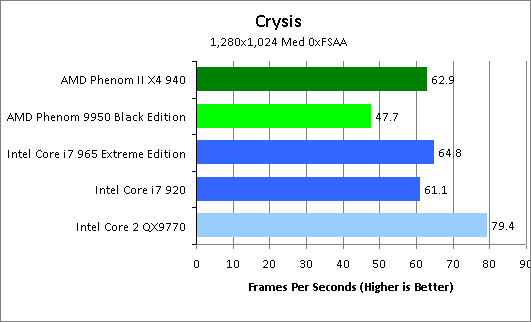
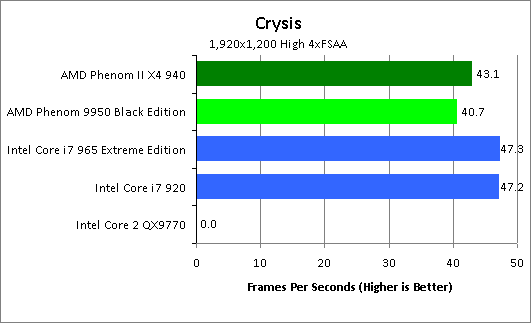
Unfortunately, our QX9770 test bed refused to run Crysis at 1,920 x 1,200 with 4xAA but even so, I think we can safely guess how things may have panned out. The QX9770 would probably have just crept ahead in this otherwise largely graphics card limited situation.
While it’s clear the new Phenom doesn’t leap ahead of the competition it has done the most important thing and at least mostly caught up. Sure it still trails the QX9770 but then that CPU costs four times as much so I think we can forgive it.
”’Enemy Territory: Quake Wars”’
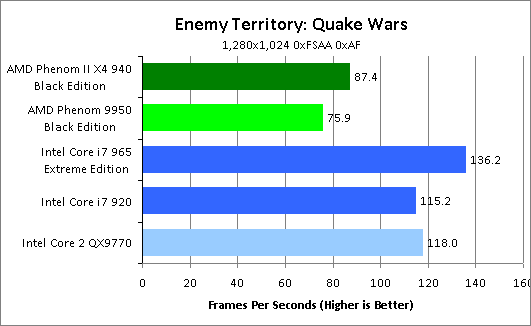
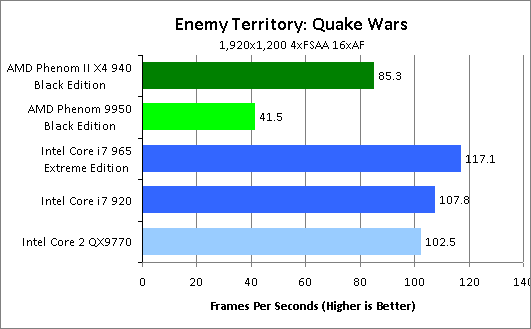
Again, AMD fails to take top spot in this benchmark but it has made some significant gains, particularly in the higher resolution test. So far, so pretty good.
Perhaps the next most obvious task for a powerful CPU in a desktop PC is video encoding. Whether it’s for editing your family videos or re-encoding your favourite videos to an iPod-friendly format, video encoding is becoming more and more common and of course it’s still a very CPU intensive task too.
We’ve used two scenarios for testing video encoding performance. The first is our age old test of re-encoding a portion of DVD quality MPEG-2 video into the open source Xvid format. This test is a bit long in the tooth as the version of Xvid we use is quite old so not multithreaded (not to mention the fact that the source footage isn’t even HD) but in being so it gives us a very reliable indication of single-core performance.
The next scenario takes a section of 1080p footage, again in MPEG-2 format, and re-encodes it into the h.264 format. This is a much more up to date test as the source material is full HD and the h.264 codec is about the most advanced video format currently available. We also use the open source converter, AutoMKV, for this task, which fully supports multi-threading.
”’VirtualDud – MPEG-2 DVD to Xvid”’
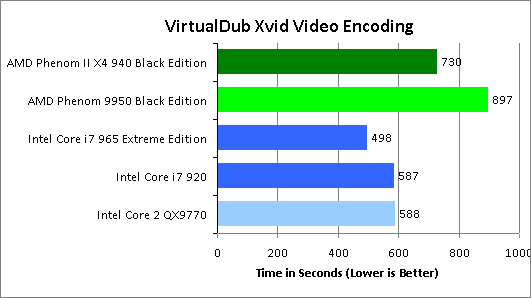
Although there’s still a clear deficit to make up and AMD’s clock for clock performance still has some way to go, the Phenom II 940 takes a significant step forward from where it was.
”’AutoMKV – MPEG-2 1080p to h.264”’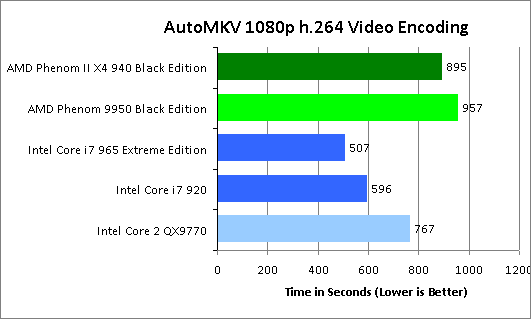
Things are less encouraging in this multi-threaded test where not only does the new Phenom pale in comparison to Intel’s chips but also doesn’t seem to make as much of a gain over the older Phenom.
While many people will associate 3D performance with a graphics card, for CAD applications a lot of the grunt work is still performed on CPUs so this is something we’ve put to the test. We use two industry standard tests, called POV-Ray and Cinebench. Both programs can be freely downloaded and the benchmark begins with just a single click so they’re a really easy comparison tool if you fancy seeing how your system shapes up.
Cinebench has both a single-threaded and multi-threaded test while POV-Ray is just multi-threaded. Slightly disappointingly, Cinebench only returns a score, rather than a time to completion, so the numbers in isolation don’t really mean anything. However, when compared they adequately show up any difference in performance.
”’Cinebench”’
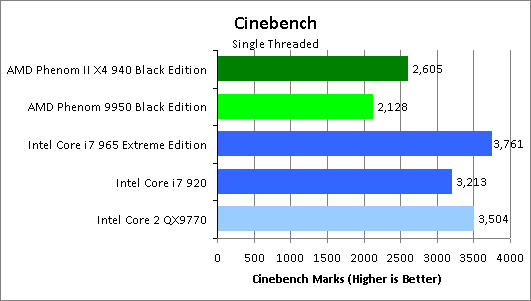

We’re definitely starting to see a trend now. Phenom II is a significant step up from what came before but clock for clock it still can’t come close to the competition from Intel. And when you take multi-threaded performance into account the decision seems even clearer.
”’POV-Ray”’
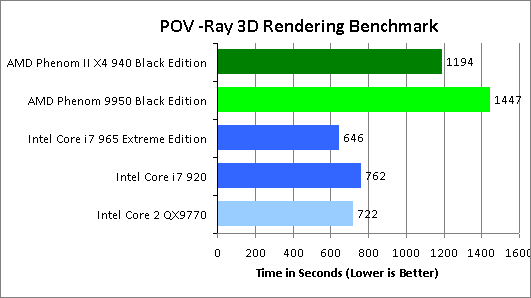
Yup, more of the same here.
”’Photoshop Batch Processing”’
For this test we run all the auto-adjustments available in Photoshop on a large collection of images and time how long it takes to complete. It’s an old test that isn’t multi-threaded but it is incredibly reliable at demonstrating differences in single-threaded performance.
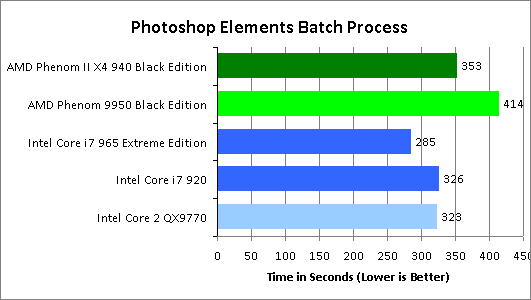
Things are back on track here with Phenom II improving significantly over Phenom and closing the gap between it and the competition from Intel.
”’WinRAR File Compression”’
Though zipping and unzipping files is a fairly quick and easy task, the frequency with which a heavy computer user has to do it means saving five seconds each time you unzip something is a real boon. We therefore feel it makes for an interesting test of system performance.
This test is split into two parts. The first times how long it takes to compress a large video file and the second records how long it takes to compress the folder of photos used in the above Photoshop test.
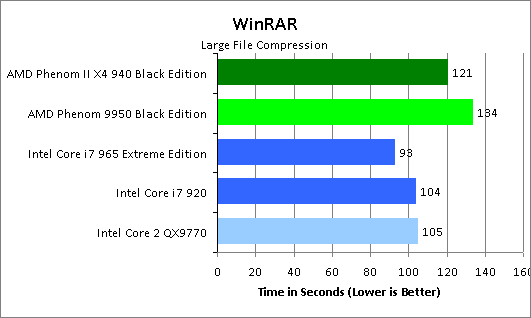
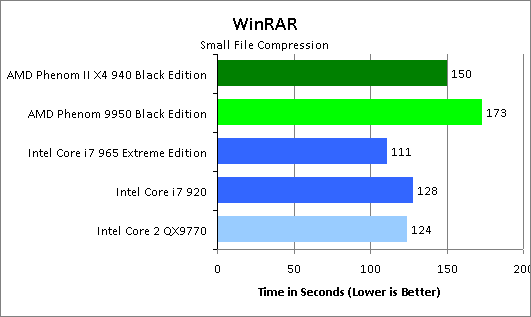
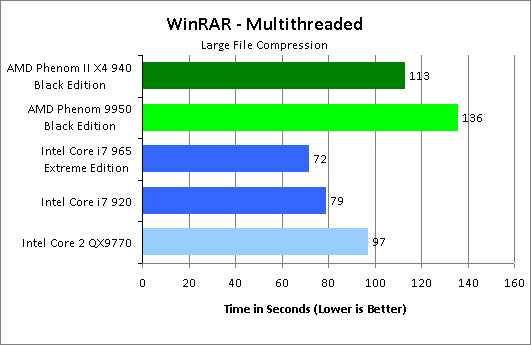
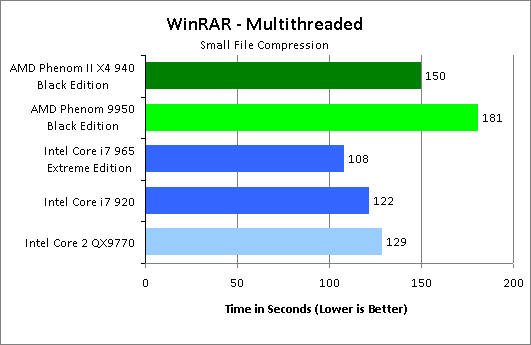
Ah, encoding MP3s. No matter how many advances there have been in audio formats and even with the proliferation of online music services, encoding our audio CDs into MP3s is still a stalwart of a computer’s regular tasks. So, let’s see how the Phenom II holds up.
”’Singe-track, single-thread encoding”’
It’s the way it always used to be done. One track after another until the album’s finished. For this test we encode 11 tracks using the LAME encoder.
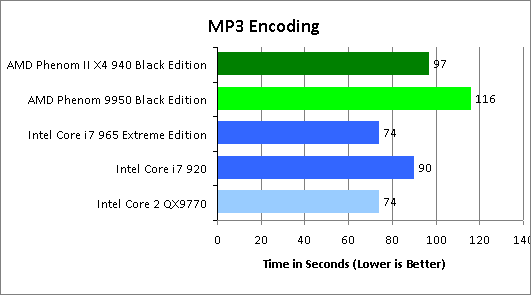
”’Single-track, multi-threaded”’
A slight improvement over single threaded encoding, this method will take advantage of multiple cores for each track it is currently encoding. This test encodes the same 11 tracks and uses the multi-threaded version of LAME.
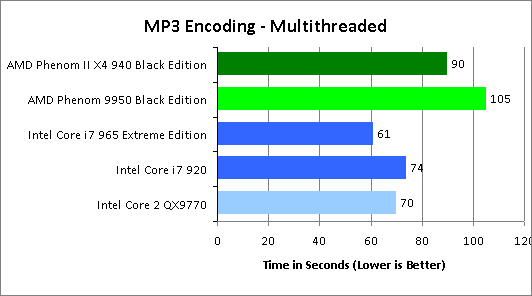
”’Multi-track, multi-threaded”’
Finally, we have the quickest method; encoding as many mp3s at once as there are cores. We used DBPowerAmp to manage the batch processing of the same 11 tracks.
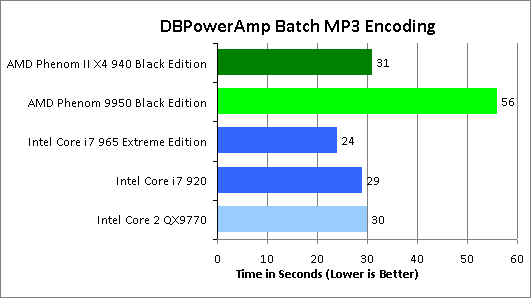
Wow, now that’s an improvement! The first two tests show a similar trend as all our other tests but the last one is really nice to see.
”’Power Consumption”’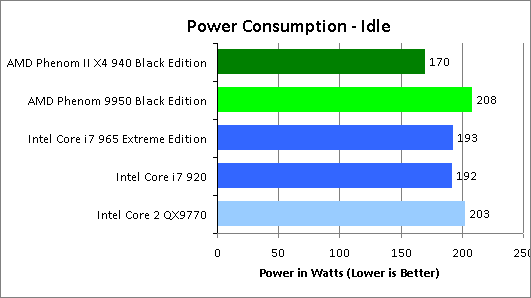
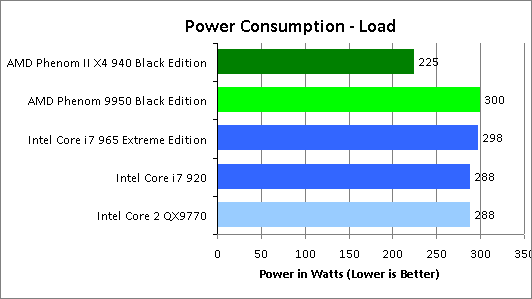
Of all the tests we’ve performed here this is the one that really tells the story of Phenom II. Along with decent performance gains (mainly due to AMD finally being able to get its CPUs running at higher clock speeds) there is a significant drop in power usage. So significant that the 940 is the lowest power CPU on test. Even accounting for the fact you get more performance for the power outlay of Intel’s processors, the difference is still marked enough to be worthy of high praise.
”’Overclocking”’
One of the biggest problems with the original Phenom was that AMD simply couldn’t get the chips running fast enough to compete with Intel. However, with its move to a 45nm manufacturing process AMD has suddenly found a huge amount of headroom for increasing clock speeds. This is reflected in the fact that the launch Phenom II runs at 3.0GHz, which is 400MHz faster than the previous best of 2.6GHz. Further to this, though, AMD claims these chips should easily hit 4.0GHz. So, with the Phenom 940 being a Black Edition (it has an unlocked multiplier) you could have an overclocker’s dream.
We put this to the test by having a quick go at overclocking our 940 Black Edition. We didn’t add exotic cooling or fine tune our overclocking, we just upped the multiplier and added a little bit of extra voltage (+0.100V). As a result, we were able to get 3.6GHz running stably. This wasn’t miraculous but it’s a huge improvement over the old Phenom. The increase in clock speed translated into our Cinebench scores improving from 2,605 (single) and 8,667 (multi) to 3,103 and 10,030 respectively – an average increase of around 17 per cent. Likewise our automkv video encoding test time dropped from 895s to 760s, which also equated to around a 17 per cent improvement.
The only downside was power consumption understandably went up a noticeable amount. However, it still remained our lowest power chip on test with idle consumption of 185W and load consumption of 270W. 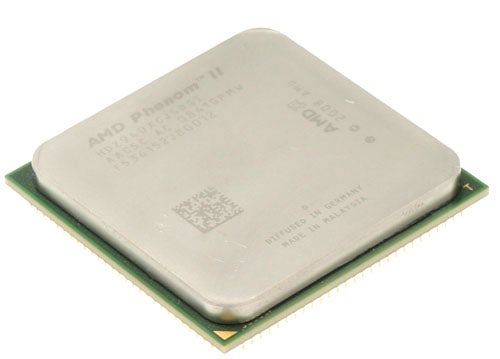
”’Value”’
You can tell AMD knows these CPUs are a big improvement over what came before as they’ve priced these much less aggressively. When they first launched, the fastest Phenoms were available for only £155. In contrast, the Phenom II 940 is likely to be around £200, and may be a little more. Combined with the fact that Intel will undoubtedly drop the prices of its competing CPUs, you have a situation where, in isolation, neither Intel’s nor AMDs CPUs offer a clear value advantage. What we can say, though, is that AMD has come up with a very competitive part that should be adequate for the vast majority of people.
”’Verdict”’
It may not have stolen the performance crown from Intel but with its new Phenom II quad core CPUs, and in particular the 940 Black Edition we’re looking at, AMD has finally become competitive again on the CPU front. Unless you must have the fastest and are willing to pay through the nose for it, then this is definitely a CPU to consider.
Trusted Score
Score in detail
-
Value 9
-
Features 7
-
Performance 8

